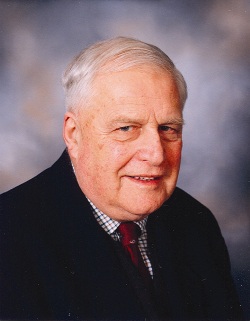 Geological all-rounder who, after a varied international career, dedicated his retirement to reacquainting fellow geologists with their subject.
Geological all-rounder who, after a varied international career, dedicated his retirement to reacquainting fellow geologists with their subject.
Joe McCall was born in London and educated at St Edward’s School, Oxford, going up to Imperial College to read Chemistry in 1938. He was in Part Two when the War intervened; though by that time he had already taken a geology subsidiary (with H H Read) and vowed to return to study geology if he survived. Joe sailed to Madagascar in 1942 where he was responsible for organising transport during the successful campaign to oust the Vichy French. Sent thereafter to East Africa, he explored the Great Rift Valley, which further encouraged his geological ambitions.
On returning to Imperial Joe took up geology, enjoying the tutelage of Read, Illing, Wood, and Pitcher. By the end of year three of the four year course, Read asked Joe to do a PhD. Research in Robert Shackleton’s Donegal Project followed, centring on the Creeslough area, where Joe described the Horn Head Slide, comparing it to the Ballachulish Slide recognised by Sir Edward Bailey. Joe finished in just under two years, his work receiving praise from both Arthur Holmes and Doris Reynolds.
After graduating Joe (who had learned Swahili in Africa) entered the Colonial Geological Survey, spending two years siting water boreholes for farmers and government institutions and researching the caldera of Menengai. In 1953 he mapped a dozen carbonatite complexes around Gwasi on the shores of Lake Victoria, conclusively disproving the notion that the then mysterious carbonatite rocks were any kind of metamorphosed limestone. He also mapped the Neoproterozoic rocks bordering the Gregory Rift. Work in Kenya continued after marriage in 1956, but with a family to support he became Senior Lecturer at the University of Western Australia, Perth, teaching petrology and structural geology and curating the meteorite collection in his spare time. He also mapped Kenya’s Silali Volcano and Ambrym (Vanuatu).
Joe left academe in 1970 to become a consultant on mining projects until 1976, when he returned to the UK – and was assigned to a reconnaissance project in the Makram, Southern Iran, managing (just) to complete the primary mapping of an area the size of England as the Revolution gathered pace. Writing-up took three years. Joe continued to work as a consultant, with Camflo gold mine (Quebec), and with GAPS (Putney) where he worked on a wide range of geoenvironmental projects.
Retirement in 1991 heralded the beginning of another, 20-year career dedicated largely to Geoscientist, the successor magazine to the Institution of Geologists’ British Geologist. Joe remained an Editorial Adviser until his death – covering a total of 225 issues.
Joe was also active locally with the Gloucester Geology Trust, was Consultant Editor on Elsevier’s Encyclopedia of Geology (2005), published 17 books, and hundreds of research papers. He received the Society’s Coke Medal (1994), the Distinguished Service Award (2011) as well as the Distinguished Service Award of the International Union of Geological Sciences (1997). He was buried in South Cerney, the Gloucestershire village that had become his home, leaving wife Rosemary and children Bridget, Fiona, and Chris.
By Ted Nield